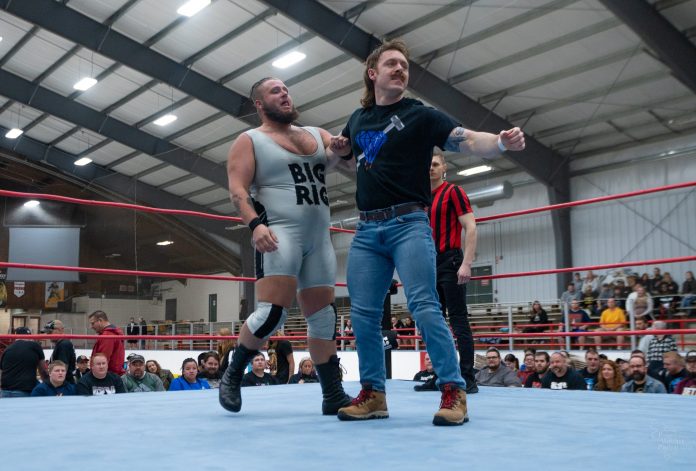
Professional wrestling, the blend of athleticism and spectacle, has produced some of the most over-the-top, flamboyant, and charismatic personas in any field of entertainment. The glitz and the glamour mixed with the grittiness of in-ring action allows for a very unique genre to make an impression on its audience. Of course, along with the drama that can be created within a sports entertainment narrative, colorful characters also have a chance to become a part of the fabric of the industry. From the local independent gigs to the major leagues, the ability of an entertaining character to draw the audience remains one of the pieces of the foundation of the business.
One of the most memorable examples of this concept was the rather cartoonish era of the early-90s when national scandals painted the pro wrestling industry in a rather negative light. In an effort to soften the image of the sport, a new cast of over-the-top personas were spotlighted. While the industry was in a slump because of the previously mentioned negative publicity, the domino effect in an attempt to clean up the image of the sport led to characters that are still fondly remembered today. Kamala, the real-life James Harris, had his first major break as a terrifying cannibal in 1982, which was a decade before he appeared equally as terrified of The Undertaker’s casket at the Survivor Series.
As a way to make programming more family-friendly and thus more easily identifiable for a younger audience, in addition to Bret Hart’s rise as the top “good guy” star in the company, a myriad of profession gimmicks made their way on-screen during this era. As with anything else, this experiment yield mixed results. Duke “The Dumpster” Droese as the neighborhood trash collector or TL Hopper in the role of the resident plumber of the WWF didn’t exactly print money. However, Mike Rotunda working as the tax man was very memorable because who doesn’t want to see the IRS take a chair shot?
While the former Captain Mike didn’t actually prepare audits every April, some of the characters that made such an impact on a generation of fans, were based on the real-life performers before their wrestling careers. For example, Paul Bearer was the real-life mortician William Moody before he broke into the pro wrestling circuit. His real experiences in the funeral industry undoubtedly allowed him to flourish as the advisor to the previously mentioned Undertaker. When a pro wrestling character is based on some aspect of reality, it allows for the most authentic presentation possible. Sure, Percy Pringle III had a solid run early in his wrestling days as a Bobby Heenan-inspired manager in World Class Championship Wrestling in Texas, but it was his role as the mortician sidekick that allowed him to reach national notoriety and a Hall of Fame career.
That authenticity is so important because it allows the audience to connect with the performers in the squared circle.
Around the Pittsburgh area, a region that was built on the accomplishments of legends like Bruno, Angle, and Douglas, an abundance of talent look to be among the next names of the area to jump into the national conversation.
One such talent is “Big Rig” Jason Tyler, a brute with a tremendous amount of agility for his size. The youngster broke into the business in 2017, training under the International Wrestling Cartel banner, one of the longest-running and most well-known organizations in the area. A converted storage facility houses the no-frill academy, but the ring that is surrounded by plain dry way on each side provides a platform for a vast amount of wrestling knowledge. The tedious process of landing on the stiff canvas repeatedly to learn the safest way possible to protect the body from impact was far from the spectacle that Tyler saw on television, but reflecting on it, he cites how valuable the experience was for him.
“I emailed a few schools, and IWC was the first one to get back to me. Training was tough, my tryout was probably one of the worst, but I didn’t quit. The trainers were Chris LeRusso and Andrew Palace. Sometimes, I got one-on-one training a lot that helped me progress. Training taught me that physical health and conditioning is very important. I started training at 19 so I was still young and dumb, but this business has a way of maturing you quick, which I’m grateful and happy for, Jason remarked.
LeRusso, who started in the business at just 18 years old, has a twenty year career to his name and is currently the head organizer for Ryse Wrestling, and Andrew Palace remains one of the top standout stars for the International Wrestling Cartel. When the pair of trainers saw Jason progress throughout the lessons and safely complete the courses, the esteemed pair of grapplers gave him their stamp of approval. It was time for his pro debut, but just who would Jason Tyler be as a wrestling persona?
Jason didn’t have to look far to figure out who he would be in the earliest chapter of his career because he was, in many ways, going to be himself. Always aware of the show business aspect of the sport, Jason Tyler, a real-life firefighter since the age of 14, took an aspect of the family business and blended it with the wrestling business. The “Sexy Fireman” persona would borrow a page from the late Chris Farely’s playbook when the big man would strut his way to be ring in an ironic dance routine to entertain the audience. Tyler found a formula that made him standout from the pack of aspiring rookies almost immediately upon his pro debut.
“My dad was a fireman since he was a teenager. It’s in the family, my brother is a fireman, and my sisters used to be. The brotherhood aspect of firefighting is the same as wrestling. We are all one big family, even more so in wrestling because I see them more than I see my fellow firefighters,” Tyler explained.
In just the few years that he laced up his boots, Jason already made a noticeable impression on the regional circuit, zigzagging around the tri-state area for a variety of organizations. Still, he considers the comradery that he had a chance to develop with those in the industry just as valuable as his early success.
“My match with Sam Adonis in my hometown, I was a bigger back then so I know if we had the chance to tear it up these days, we could top it. Sam is a great mentor and influence on my career. Anytime I get to wrestle Zach Nystrom or Elijah Dean, whether it be tag team or singles matches, it’s always a highlight. I teamed with Bushwhacker Luke against them and that was fun. I could wrestle Money Shot every show and never get tired of it,” Tyler said.
“He’s extremely underrated, deceptively agile, but will never come close to being as good as me. He probably puts nacho cheese on his salads like a weirdo,” said the brash Elijah Dean when asked about the in-ring ability of Jason Tyler.
More recently, with a level of seasoning and a firm sense of confidence based on his previously mentioned achievements, Tyler put a sharper edge on his pro wrestling persona with the “Big Rig” moniker, a nod to his big man style, but with his signature quickness, an aspect of his career that puts him in a league of his own in many ways. When he’s not pummbeling opponets in the ring or fighting fires, he hunts ghosts and has the “Pardon The Paranormal” podcast to document his experiences. However, considering that sports entertainment has been his passion since a very young age, he stays focused on what he wants to achieve in pro wrestling.
“My goal in wrestling is just keep pushing myself because the sky is the limit. I want to make it to the top of IWC then, of course, the main goal is to get signed,” Tyler concluded.
For more information on Jason Tyler, you can go to https://www.facebook.com/5AFJasonTyler
What do you think? Share your thoughts, opinions, feedback, and anything else that was raised on Twitter @PWMania and Facebook.com/PWMania.
Until next week
-Jim LaMotta
E mail [email protected] | You can follow me on Instagram & Facebook @jimlamotta89







